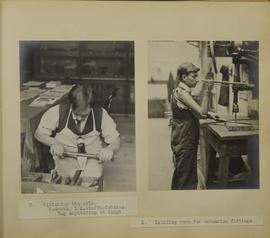The fact that Patrick is missing from the 1921 census (see The Irish Pimpernel) is doubly frustrating due to the amount of information recorded on that occasion. The occupation and place of employment are both part of the census return. For example, his brother-in-law Ernest Delves worked as a Suction Gas Plant Attendant at John Edee Butt & Sons, Timber Merchants, in Portslade. Even if Patrick was away on a training scheme at the time, he should still have been recorded. Perhaps his name was recorded incorrectly.
Patrick was discharged from the Army just 17 days before the Armistice. This may have given him a slight advantage in accessing some training schemes. Wounded men, some with far worse injuries than his, had been discharged “having suffered impairment since entry into service” (to quote the phrase used on his records) regularly since the war began in August 1914. Once it was clear that fighting was unlikely to restart, demobilisation started in earnest. Men were being discharged from the armed services at a rate of 20,000 a day. The War Economy had to switch back to peacetime requirements. Dresses and suits not military uniforms. Tractors for farmers not fighting vehicles. (Or swords into ploughshares.) Furniture for the home not desks for the military. This takes time. And the process is rarely smooth.
According to Denman and McDonald (“Unemployment statistics from 1881 to the present day”, Central Statistics Office, published Jan 1996) unemployment was extremely low (less than 1%) at the end of 1918. A recession started in April 1920. By May 1921, the unemployment rate had risen to 23.4%. Generally, it remained above 10% throughout the 1920s. It was into this environment that Patrick was seeking work, along with tens of thousands of other disabled servicemen. They were also competing with hundreds of thousands of able-bodied ex-servicemen.
The Ministry of Pensions established the Civil Liabilities Scheme in 1916 which provided men with grants for training and education. Responsibility for this scheme was partly devolved onto the Ministry of Labour which took responsibility for providing these training opportunities. In 1918, both Ministries jointly established the King’s Fund for the Disabled which helped men establish their own businesses. Those who could not find employment received an out of work donation provided by the Ministry of Labour for up to forty-six weeks after demobilisation. The Ministry of Pensions was responsible for financial compensation and the Ministry of Labour for work. Cooperation between the two ministries seems to have been reasonably well-co-coordinated. Their complementary roles helped in alleviating unemployment amongst disabled men.
The Kings National Roll Scheme (KNRS) was a private initiative, established in Manchester by Henry Lesser Rothband in 1915. He proposed that companies should have 5% of posts in their workforce reserved for the disabled. It took until September 1919 until the idea was taken up nationally. Even then, it was a voluntary scheme. By that time, it was clear that a series of ad hoc measures would not meet the needs of the very large numbers of disabled ex-servicemen. Companies were encouraged to sign up to the scheme. The Government even reserved some contracts for participating companies. In a few places, naming and shaming took place for companies that were slow to take part.
Another initiative was the Industrial Training Scheme. It was established by the Ministry of Pensions, and transferred to the Ministry of Labour in 1919. 30 trades were selected involving 600 different occupations in which men could train. The Industrial Training Scheme Training took place in government institutions for approximately nine to twelve months. From there, men were placed in further training, or `improverships’ with private employers. Trainees received allowances for their dependents and the cost of training was defrayed in part by both the government and the employer. During the training period, pensions were increased to the sum of 27s, 6d; the equivalent of a maximum disability pension. Whilst in training men also received a 5s training allowance, free medical care, free room and board and a family allowance if training necessitated an absence from their dependents. It is possible that Patrick benefitted from one of these schemes.
An unforeseen consequence was that some of these schemes produced far more workers than the particular sector could absorb. Centrally managed schemes are often slow to react.
(Photo from University of Westminster)
I do not know which, if any, of these schemes helped Patrick. And if so, when. All that is known is that he was recorded as a labourer (albeit one who was disabled and unable to work) when he married in 1920 and later appears as a gentleman’s hairdresser.
I am grateful for much of the information in this post which I discovered in a PhD thesis submitted to the University of Leeds in 2007. https://etheses.whiterose.ac.uk/id/eprint/680/1/uk_bl_ethos_485260.pdf

